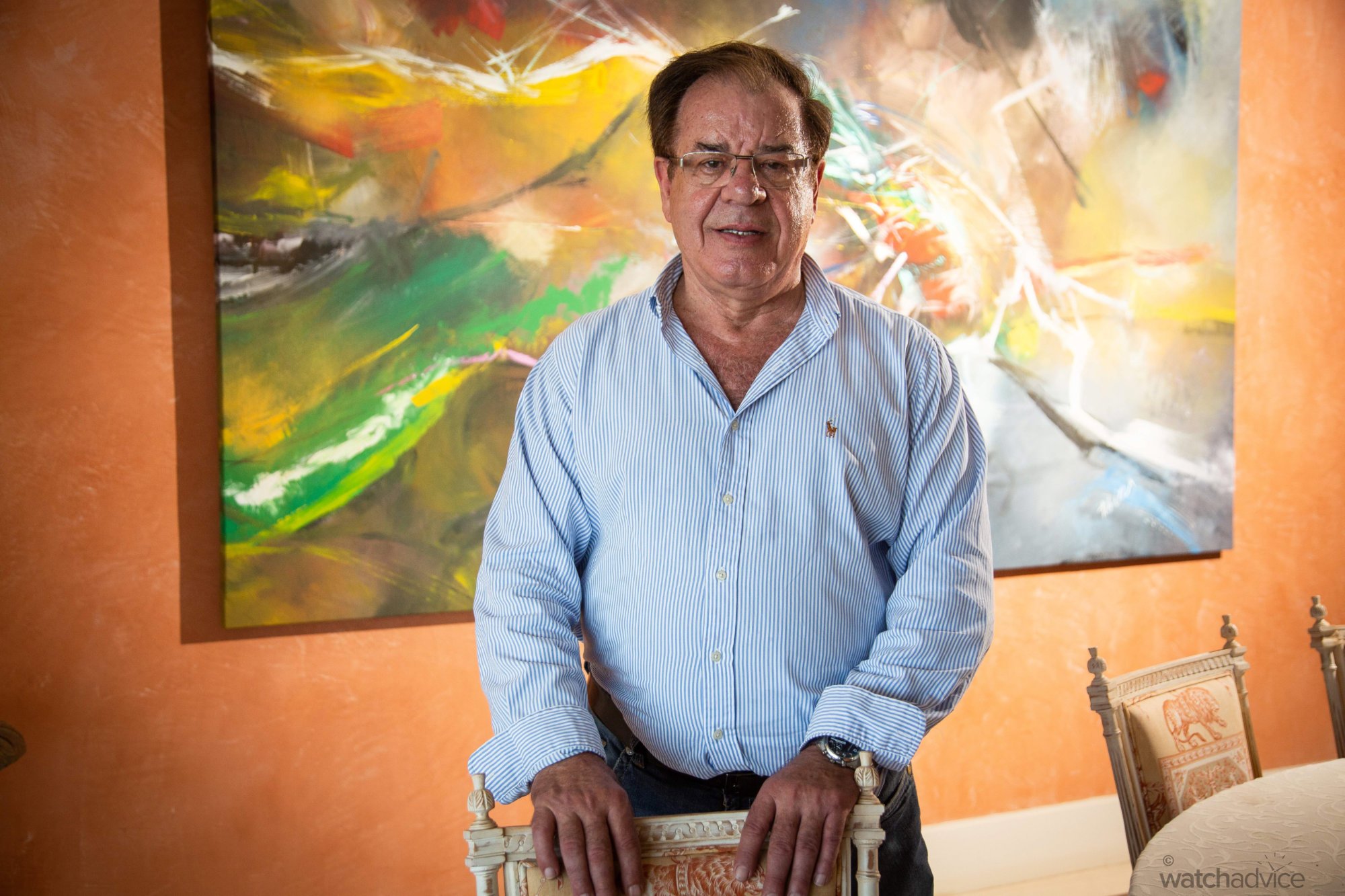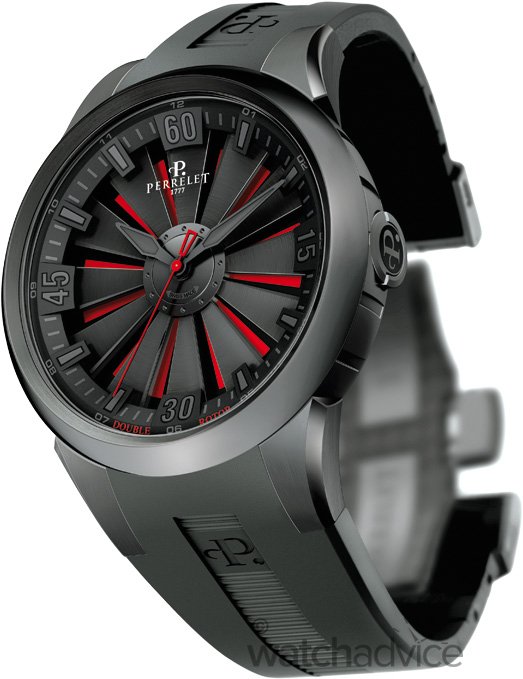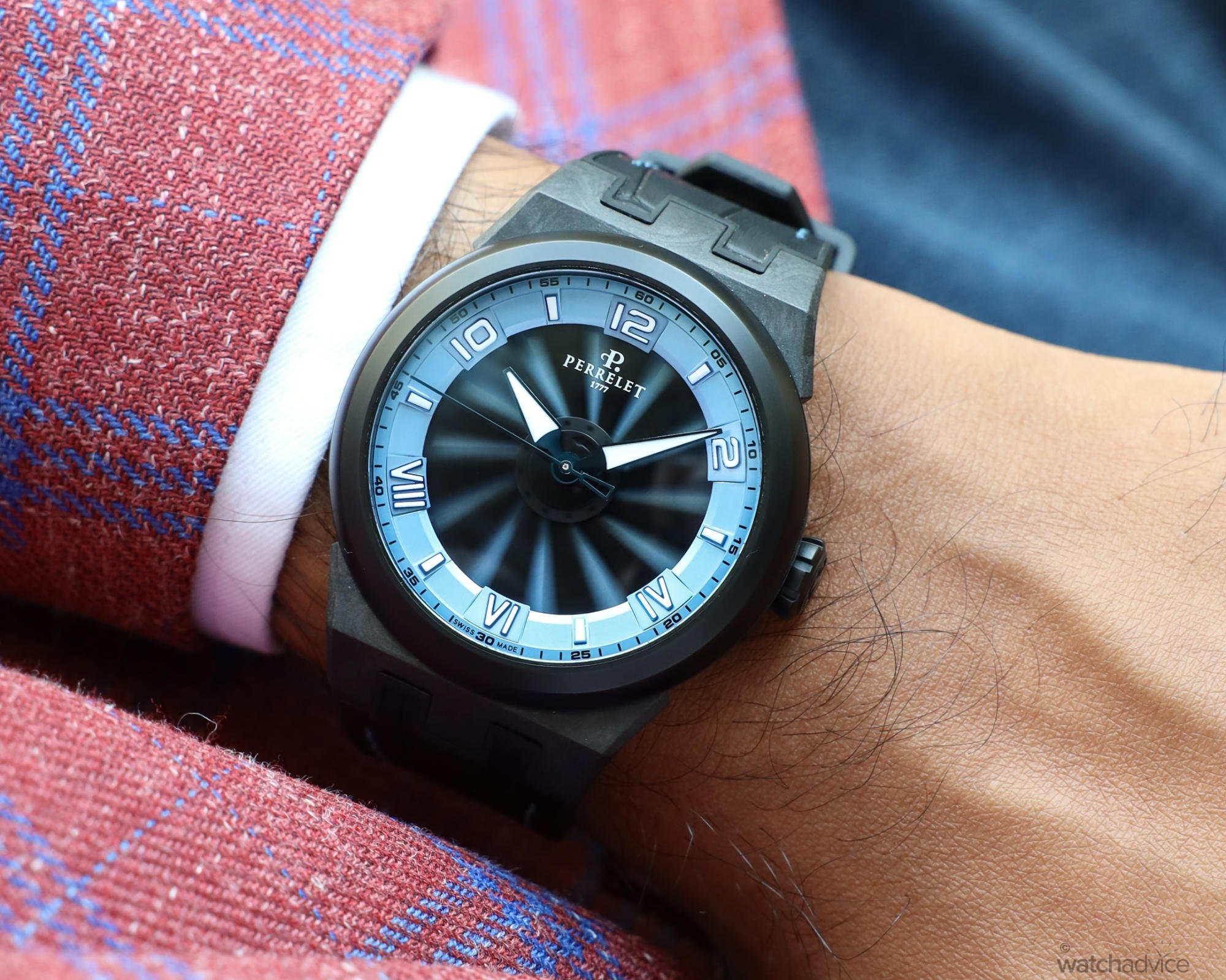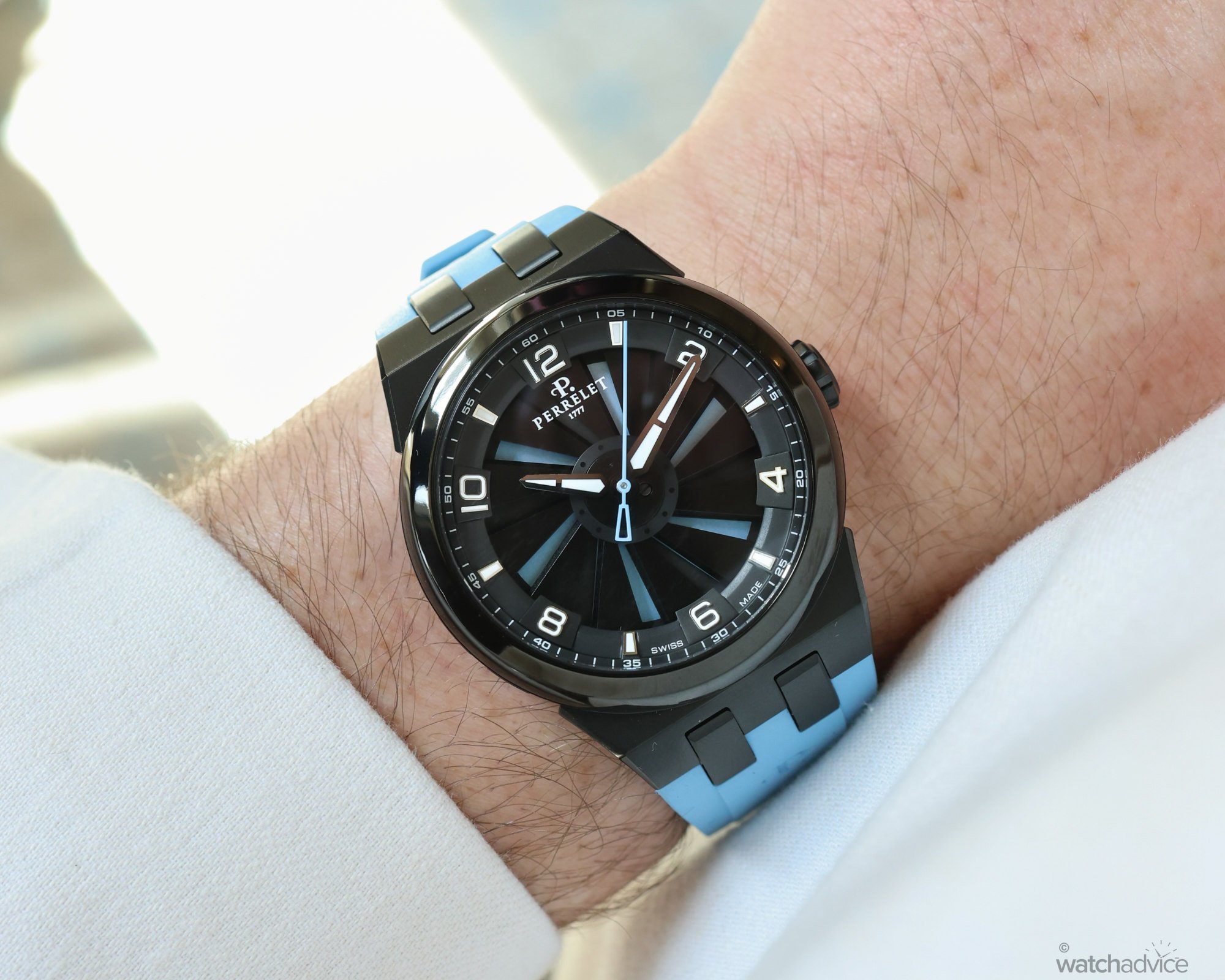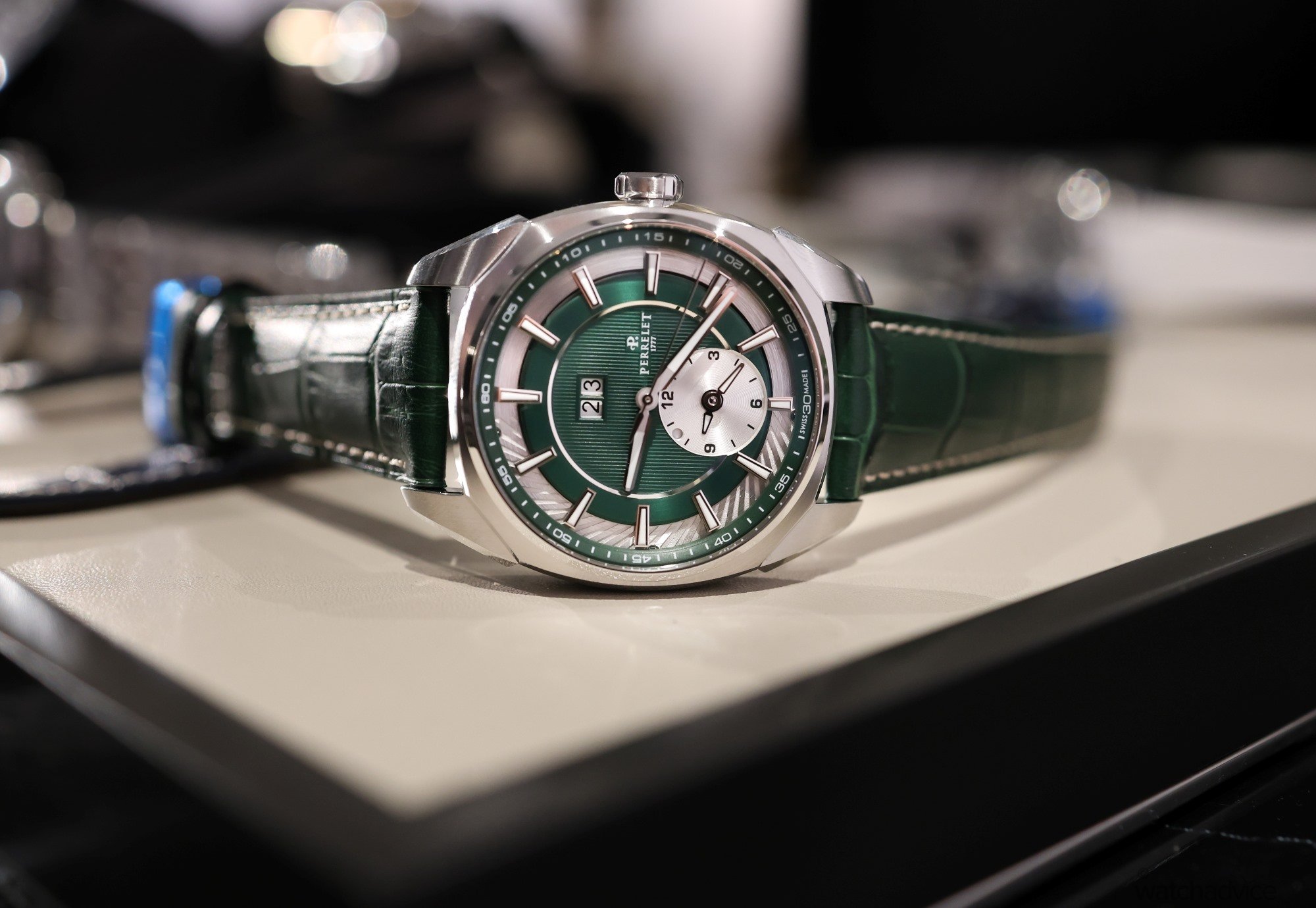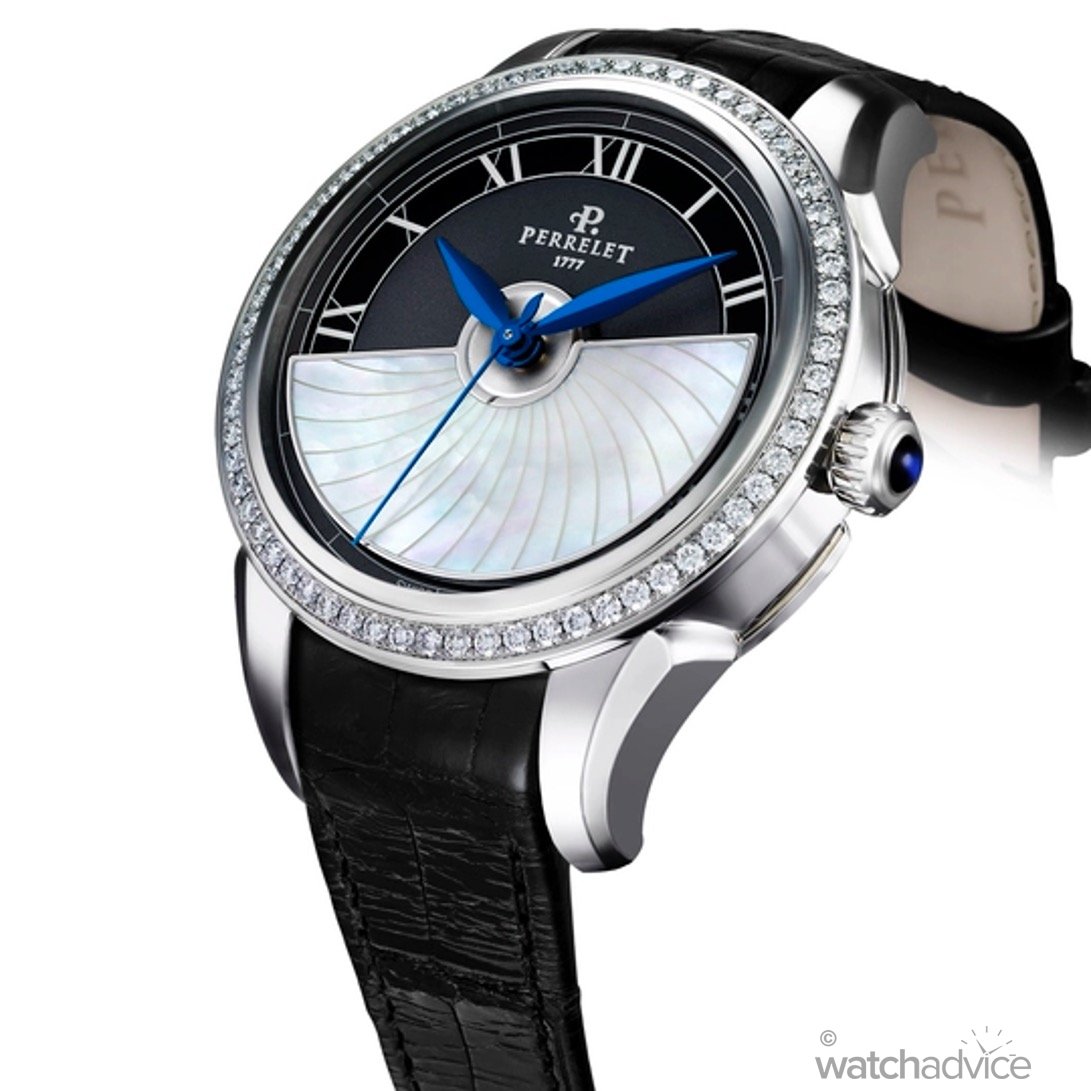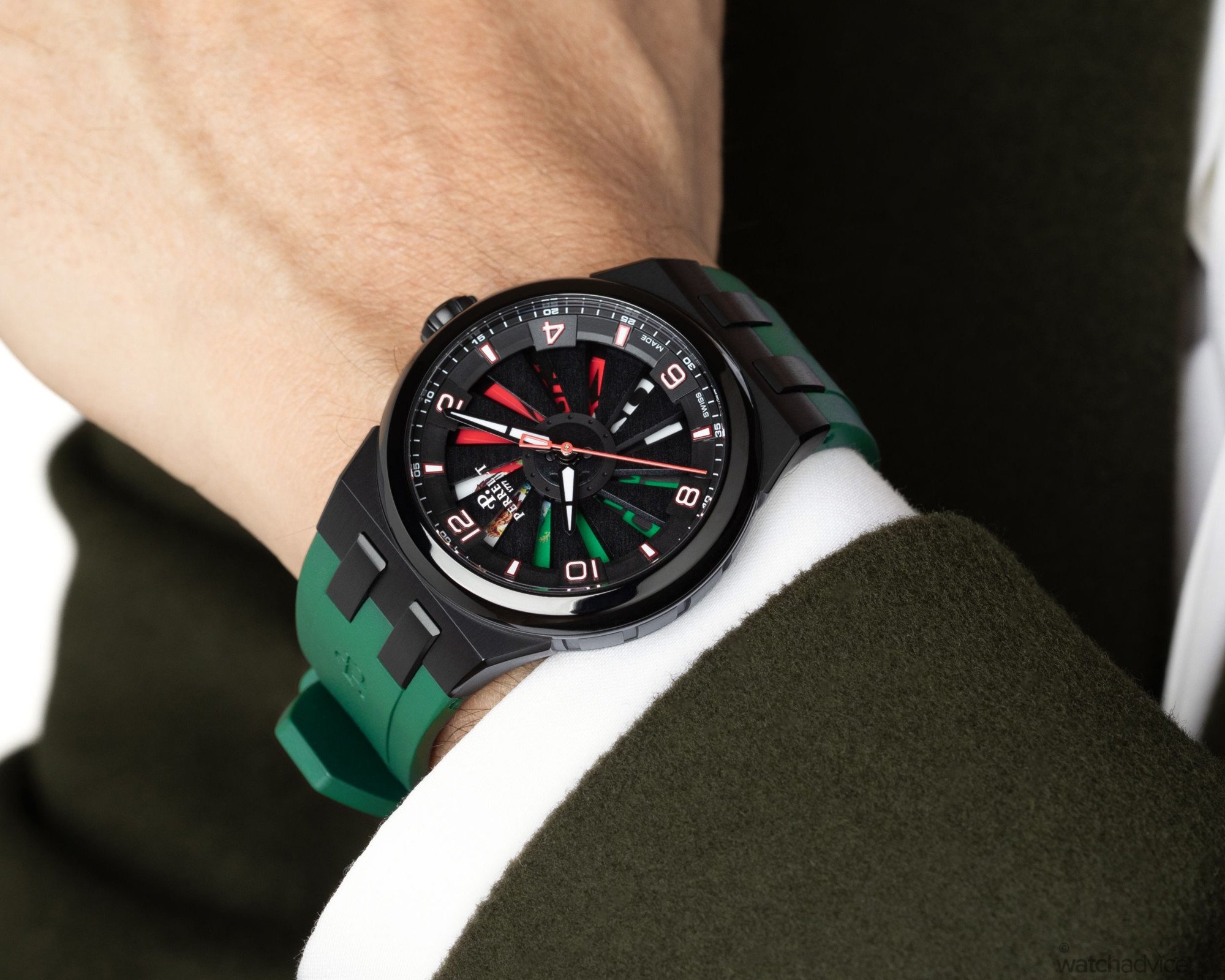During Geneva Watch Days, we caught up with Hugo Lesizza, brand director for Perrelet to discuss the brand, its direction and deep dive into their latest Turbine releases.
Perrelet is quite possibly one of the most historically significant brands in the watch industry, yet, it is arguably one of the more underappreciated brands. Now this may seem like a strong statement, but think about this: Abraham-Louis Perrelet, who studied under Abraham-Louis Breguet, was responsible for the automatic winding movement that we all now take for granted, and with roots tracing back to 1777, it’s one of the oldest brands around, albeit via different incarnations over the last 200 years or so.
These days, Perrelet is more known for their Turbine models, unmistakeable when you see them, and while they come from a serious watch-making background, and even today have their own manufacture, they are still a bit of fun on the wrist, something that is part of the Perrelet strategy. When the Watch Advice team was in Geneva last month for Geneva Watch Days, we caught up with Hugo Lesizza who is the Brand Director for Perrelet and took a bit of a deep dive into what makes Perrelet tick…so to speak!
Like many people in the Swiss Watch Industry, Hugo is originally from France and now works in Switzerland, heading up much of the Perrelet operations, which is now part of the Festina Group owned by Spanish entrepreneur, Miguel Rodrigeuz. In his words:
“I’m the brand director for Perrelet, so basically I’m in charge of a bit of everything for the brand, from the design, coordinating all the processes for development with the teams in the manufacturers and I’m also responsible for sales and marketing and helping our partners worldwide to develop the brand.”
“We are very lucky because we are part of a family business but a big group (Talking about Festina). We are an independent watch-making group owned by Miguel Rodriguez, who is a Spanish entrepreneur. He started the business in the 80s with a lifestyle division, and as you know, it was the beginning of the quartz movement, so it was a boom at that time. He was quite successful in spreading the distribution of his brands worldwide and then starting to enter into the luxury segment as a result.”
As part of this acquisition strategy, Festina acquired Perrelet in 2004 and in 2008 bought a company called Soprod, which was a movement Manufacture, which was a sort of a coup for them as this gave Perrelet the ability to make its own movements and be an integrated brand with a vertical manufacturing approach.
“That’s why we say that we are an independent manufacturer because we do have a sister company developing exclusively for us, so we are very lucky for that – it’s a strength of the brand, giving us flexibility for new developments.”
“Perrelet is known especially for the Turbine dating back to 2009, so it’s still contemporary let’s say. People even know the Turbine before knowing Perrelet and its history, that’s why it’s very important for us to insist on the legacy of Perrelet which dates back to 1777 when Abraham-Louis Perrelet, who was Swiss and born in Le Locle, in the Canton of Neuchatel invented the first automatic movement in the industry. So basically we invented the rotor which wound the movement, and as such we keep this legacy with us, and we keep developing the Turbine, innovating with design and new materials.”
This statement here reflects my opening remarks somewhat. Perrelet is an old brand, and the founder, Abraham-Louis Perrelet, all the way back in 1777 devised the automatic movement, albeit for pocket watches at the time. Clearly, these were nowhere near as refined as today, but this invention paved the way for others to develop and refine over the years to what we have today.
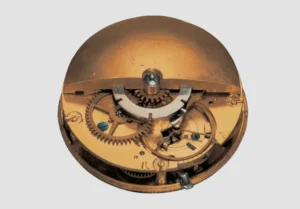
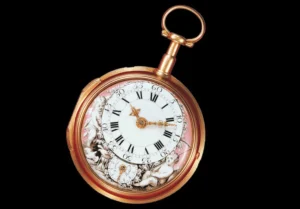
Perrelet has changed over the years, but the one thing they are known now for, which Hugo has already touched on, is the Turbine collection. Some people think that the turbine itself acts as a winding mechanism, however, it’s purely aesthetic and a bit of fun, something different for people to have on their wrists. But before we delve into that, our curiosity is piqued a little about where the inspiration comes from, and how does Perrelet go about designing this?
“It’s aesthetic and they are only at spinning very fast because the idea is to create a very eye-catching effect to play with colours, with thematics, that’s why we have a good dynamic in the collection. Basically, the product team in charge took the inspiration for the turbine from the turbines on the jet engine, which was the initial inspiration for the development of the turbine. It took time to develop it because as you know in the watch-making industry you have constraints, which is not easy to handle, and with the turbine, we had to get the balance and spinning just right, even down to developing the ball bearings it spins on!”
“So as soon as you’re moving the wrist, it is spinning very fast, creating this very fluid motion. This is why people ask if it is connected to the moment, or if it is functional. We don’t connect the turbine to the movement like an oscillating weight, as if we did, it will spin very slowly and we would lose this eye-catching effect.”
Once Hugo explains this, it makes sense. The spinning is for effect only, and as such, Perrelet wanted to make sure it spins effortlessly and gives that constant effect, and when doing so, shows off the dial underneath, which are now getting more and more colour, patterns, designs and let’s face it, fun! Another way Perrelet archives this is the material the turbine is made from…
“The turbine is made of aluminium so it’s very light with a counterweight below the turbine. This creates the ease and speed of the movement with the ball-bearing system designed to spin very fast.”
Now, if you’re thinking, “How hard is it to put a spinning blade on a watch dial?” The answer is, that it isn’t all that simple. Honestly, nothing in watchmaking is simple, and when you start playing around with new mechanisms, new movements, and even new sizes, there are a lot of elements that need to be taken into account. Hugo explains this.
“There are a lot of influences and parameters of course. To be honest, we tested many materials for the turbine. We tried titanium and other metals, but aluminium for us, in the end, seems to be the ideal one because of the lightness. Depending on where you put the counterweight, and what type of material you are using, it will spin the right way or it won’t. If not done exactly right, sometimes it can stop because it can touch certain elements of the dial ring, so it’s very difficult to develop.”
Thankfully, Perrelet has been doing this now for more than 10 years and has refined this quite a lot over the years. This is all done with their in-house manufacture, and as I mentioned, they’ve encountered many challenges around this once they started to play around with the watches, such as new sizes.
“Even the ball bearing is in-house through our sister company and nowadays the challenges are when you are reducing the case size, you have to adapt the whole system. It has been challenging to reduce the watches down to 41mm for gents, and we will soon introduce a new size for ladies, so an even smaller case of 37mm. So it’s always challenging to touch the turbine feature when doing this.”
This brings us to the new pieces that Perrelet introduced this year at Gevena Watch Days – the Ice Blue Titanium 41 and Ice Blue Carbon 44. Having just spent the last hour or so playing around with these pieces and several other recent releases, not to mention some upcoming pieces as well, we were curious as to the thinking behind the new watches.
“So we recently introduced the Carbon 44 with polycarbonate, and the Titanium with a new case size of 41mm and during Geneva Watch Days we have launched the new colour, Ice Blue. It’s very fresh, it’s perfect for summertime, but we don’t want to be mono-product – we don’t want to be focused only on the Turbine that’s why recently, thanks to our Manufacture, we developed a very specific movement: the Lab Peripheral. The Lab Peripheral has a peripheral oscillating weight located at the front of the dial, so it’s both aesthetic and functional. It is also more of a dressy watch – it’s very elegant and designed for people looking for something more conservative, more traditional, because of course, the Turbine is sporty in style and a bit conceptual. So you either like it or not, and that’s why we do offer something completely different.”
Now, Ice Blue dials are not new, many brands have been using them for years on pieces, sometimes to showcase a precious metal, other times as limited editions, and others just because it’s trendy. Hugo explains that their decision to do an Ice Blue dial is more so the latter, they’re not hiding this, and like the ice blue colour, kind of refreshing honesty!
“We are following the trend a bit with the Ice Blue. The thing is, over the years we have been using very classical colours, black or brown you know, and it was time, when we launched the turbine titanium especially, to be sporty and colourful so we wanted to bring to the market something very colourful. We already had six colours in the range, and now with the Ice Blue, we now have seven. I think the Ice Blue is a natural move, proposing pastel colours a bit and we have a new colour in the pipeline for the Turbine Titanium 41 millimetre, which is planned on being released by the end of the year.”
When the new colour is released, the Turbine range will then have eight colours on offer for people to choose from, and if you want more colour in your life, Perrelet has multiple strap choices you can mix and match with the watches.
“You can also keep, for example, the Ice Blue dial, but change the strap and play with the accessories around the watch as well. Interestingly, we will soon have across both 44mm and 41mm sizes the easy clip system so you can switch the straps easily and explore different colours!”
But what about the brand itself? As stated, Perrelet is a brand with a serious history, but now with watches that are less serious in nature, but with serious watchmaking at the core of the piece. This is something that Perrelet leans into, as it is hard to differentiate these days with so many watch brands on the market, and as an independent (so to speak) tackling the larger groups with lots of money is hard. But this is something Perrelet doesn’t shy away from Hugo explains.
“First of all the history of the brand is unique, it has a great legacy, plus the fact that we are an independent Manufacturer, and since 2019, we have developed movements with excellent reliability because the movements we use for the turbine is COSC certified. The value for money for the quality we offer is excellent, and once again, Perrelet is able to offer a disruptive design, totally different from competing brands. Our clients are people who already own Omega, Rolex, Panerai, Zenith, IWC and many other brands you can name, but they’re looking for something fun, and different, but with history, knowledge, and quality of course. Our clientele are people who know about the watch industry, who are collectors let’s say, and looking for something fun!”
Perrelet is a brand that produces about 2,500 pieces a year, which in the grand scheme of watches, is quite small when you consider some brands do limited runs of a single watch at this number. Even with this smaller number, Perrelet is one brand that is happy to go above and beyond for its clients, with Piece Unique’s, small batch numbers with individual designs and even taking an existing model and personalising it to the client’s request.
“As we are a Manufacturer, we do have flexibility so this is definitely something we offer: from unique pieces to specific customers, to small series such as 5 pieces, and watch customisation. It can be on the material itself, so for example, if a client wants the Titanium Turbine 41mm in solid gold, this is something we can do for them – produce a unique piece in a solid gold case.”
“We have specific requests, for example, we recently did a unique turbine carbon 44mm for a client who is a fanatic of the Volkswagen Kombi. He wanted a picture of his Volkswagen Kombi with his number plate on the dial, so we did this. We also included on the crystal of the caseback: “Unique Piece” with his number plate. On top of this, we developed a unique strap with a specific colour and specific stitching to match so it all tied in together. So these are the types of things we are happy to do for clients.”
While Hugo says they are more than happy to do these custom pieces, there are still challenges with certain elements on the watch, like the turbine itself. As he mentioned previously, the materials they use for this impact the way the turbine spins and the desirable aesthetic. But, it’s not impossible…
“As for the Turbine, interestingly, we used to have a Turbine in gold, so it’s possible but it’s more difficult to develop because of the need for lightness of the turbine and the way it spins. Taking this into account, we need to adapt the weight of the counterweight below the blades to find the right balance. So we can offer different materials and different colours, and we offer customization of the dial, the dial ring, and the hands. Let’s say there are no limits!”
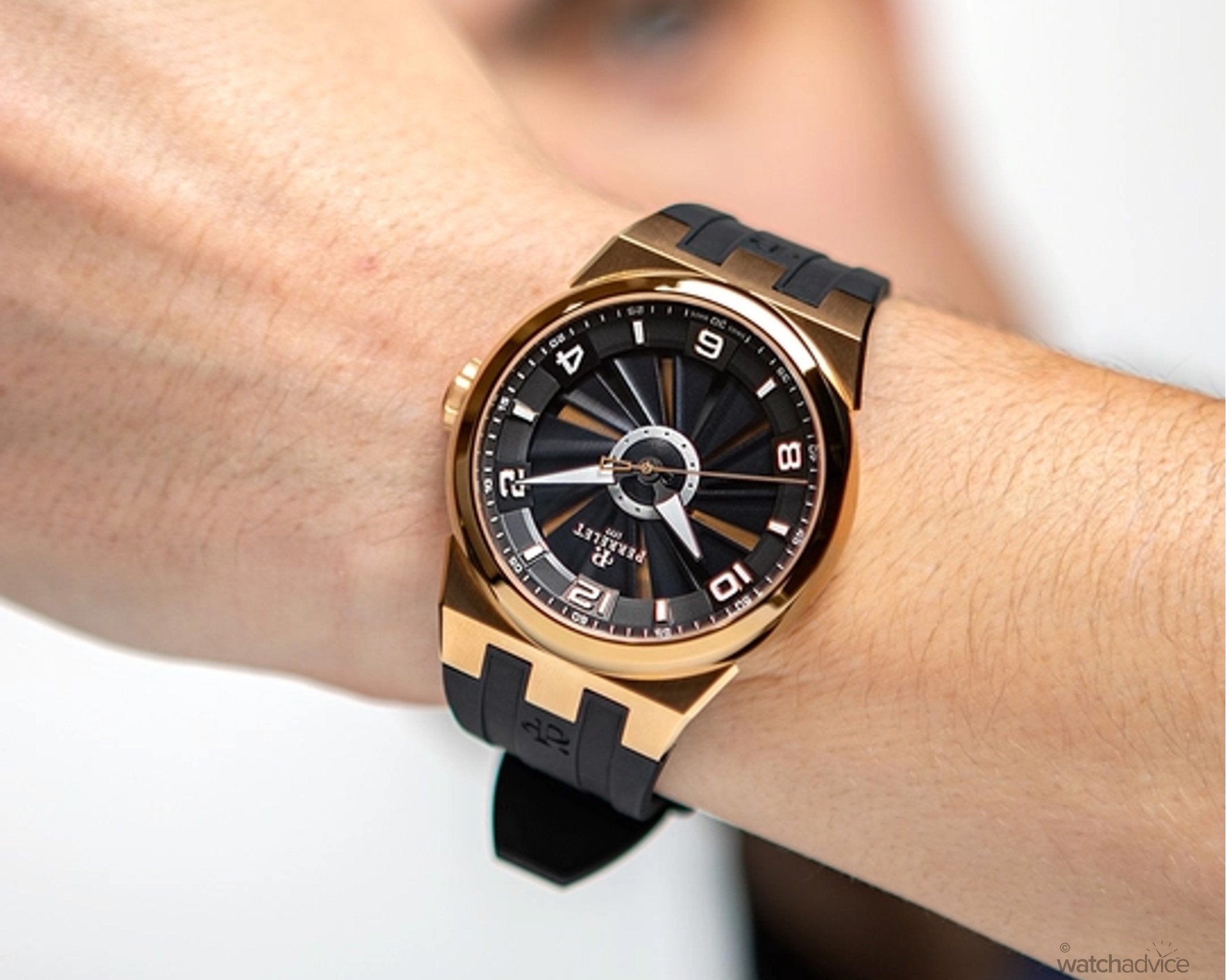
This part of the conversation got us thinking, and it seems that a brand that is happy to do a wide range of custom pieces for clients, may just have a few more fun releases up their sleeves with different colours, designs and materials.
“What we are doing now more and more, as you can see with the existing collection, most of the decoration is on the lower dial just below the turbine and you can only see it when it is spinning. Unfortunately, and I don’t know why, we never played with the turbine itself. However, in the recent limited editions we developed, we have played with Super-LumiNova on the turbine itself, and we are now exploring playing with the turbine itself and not with the under-dial, so you can have details of both levels.”
“Recently this year we released the turbine Hypnotic where we have a spiral with Super-LumiNova – both on the turbine and on the dial, creating a kaleidoscope effect and it was the first time where we explored that. It makes sense you know, to play with the turbine!”
Perrelet is also now starting to play in the world of different case materials, which adds yet another area of innovation for the brand. The latest releases in Carbon and DLC Titanium are examples of this, and from what Hugo says, just the start of this for Perrelet…
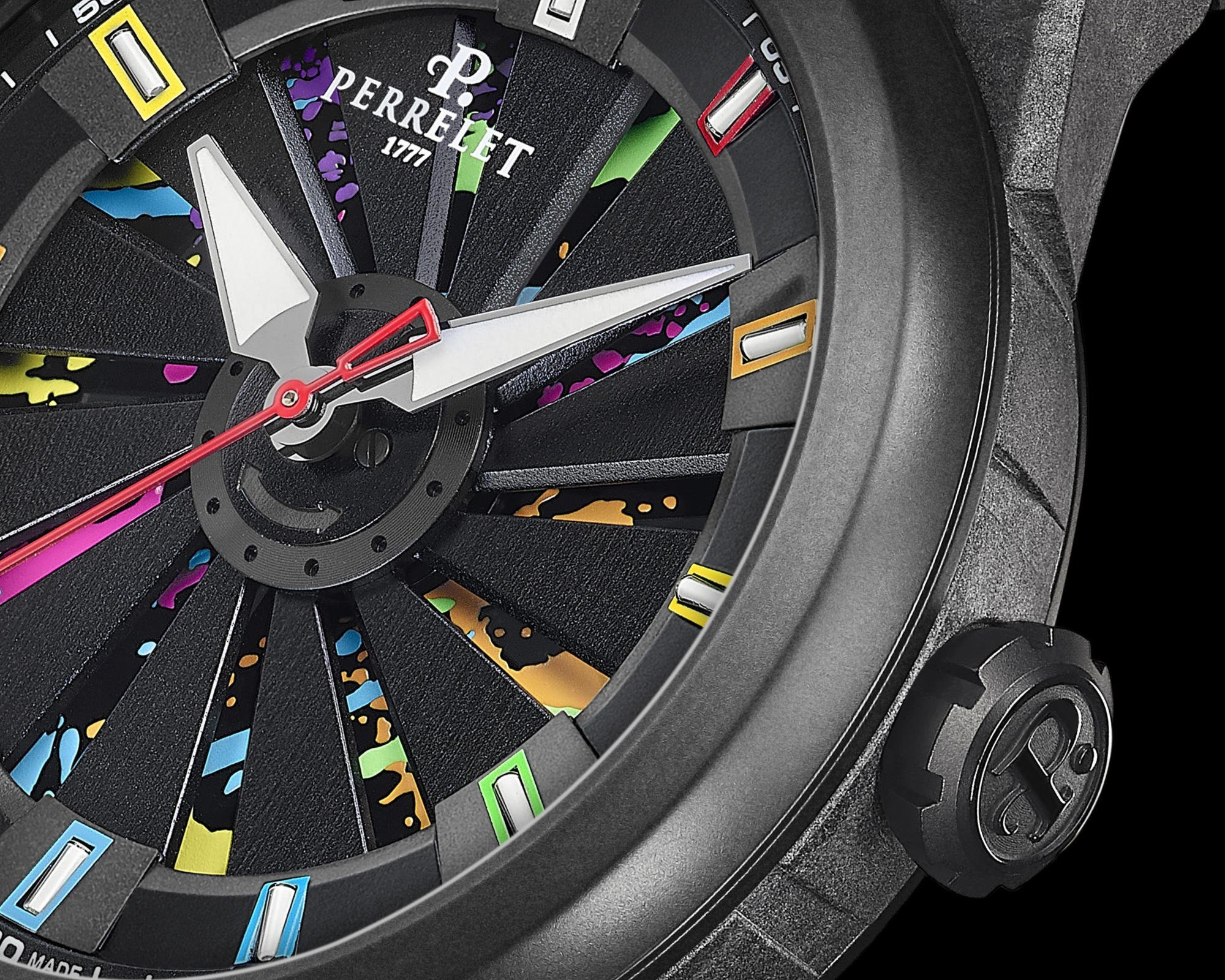
“There are new developments we have in mind because over the last 15 years, we’ve been doing only stainless steel with different coatings. However, over the last 2-3 years we have been exploring new materials like polycarbonate, carbon and titanium. What’s in the pipeline? Well, I’m sorry, but it’s a secret so I can’t tell you what we are exploring currently or in the future! (said with a cheeky laugh) but definitely we want to come out with more materials, materials that will play with the light, so yes this is definitely something we have in the pipeline!”
But Hugo does give us some insight into where Perrelet is heading.
“The next challenge will be ladies’ watches because nowadays, we are very masculine. We used to have more ladies’ watches in the past, especially with the emblematic Diamond Flower collection based on one of the signatures of the brands – the double rotor movement which was patented in 1995. Basically, you have the oscillating weight at the back connected to a rotor at the front and they are connected between themselves, meaning they are spinning at the same time. It’s both functional and aesthetic all the same time.”
“For ladies, we are looking at more jewellery timepieces than pure timepieces, such as an MLP diamond setting, so it’s an excellent alternative to key brands in the Ladies’ segment like Chopard, Bvlgari, Dior etc. We want to be back with more pieces like this in the future, and potentially will be new and new collection additions for 2025”
It seems that Perrelet is moving in the right direction, but we are curious to learn a little more about where the brand sits in Australia, and how we as a market perform against our global counterparts.
“So historically the brand is very strong in Eastern Europe. It used to be strong in Russia, but now that’s difficult because of the situation with Ukraine of course. We’re very strong in the Czech Republic, Poland, Slovakia, and Belgium because the brand has been present in these countries for decades. We’re also very strong in Mexico. We do a limited edition for Mexico each year, it is very responsive to the more eye-catching pieces, in addition, we have a strong presence with retailers, and department stores, plus we participate in the key watch fairs over there, so this is a great market!”
“We have a good presence in the US and in the Caribbean, and since last year, we have been developing a lot of the Middle East market which is becoming stronger and stronger for us. Next year the challenge is to widen Asia and Oceania including Australia. Australia for us is a new territory thanks to the new partner we have in HBC milestone. (Who put on the Sydney International Watch Fair in Sydney’s Double Bay late last year). They’re very active and very dynamic in finding ways to promote the brands, so Australia has a large potential definitely. But for us, the brand is still new there and we have to work on brand awareness, but we have some good projects for Australia and we have good expectations!”
The independent watch scene here is definitely picking up, and brands like Perrelet will only help to drive the market, its diversity and its maturity. As the saying goes, the rising tide lifts all boats, and this is true in the watch industry and here in Australia. The more brands that can be introduced and cater for different tastes, the better. With Perrelet, can we see an Australian edition coming out? Maybe…
If you want to explore more from Perrelet, go to Perrelet.com



